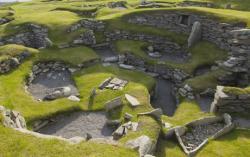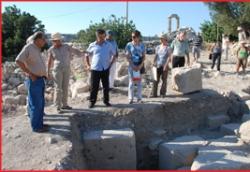- 07 SEPTEMBRE
- INDI-UNI : ANTHROPOLOGY - ARCHAEOLOGY
REGISTRATION 2011 – 2012 ONLINE COURSES
INSCRIPTION 2011 – 2012 COURS A DISTANCE
- FRANCE – Calleville - Lors de la construction de l’autoroute A28 entre Rouen et Alençon, un gisement daté du Paléolithique supérieur final a été découvert et fouillé au Buhot. Ce site en bordure de la rivière du Bec est remarquable à plusieurs titres : la rareté des sites de cette période en Haute-Normandie, son excellent état de conservation ainsi que la qualité et l’originalité de l’assemblage lithique découvert (près de 5 000 outils de silex). L’absence des restes de faune est palliée par des études géoachéologique et techno-typologique, laquelle a permis de percevoir les objectifs du débitage. De nombreux remontages et raccords associés à l’analyse des méthodes de taille et des techniques de percussion contribuent à la compréhension des différentes séquences de la chaîne opératoire.
http://www.inrap.fr/archeologie-preventive/Actualites/Communiques-de-presse/Les-derniers-communiques/Communiques-nationaux/p-13517-Le-bivouac-prehistorique-du-Buhot-a-Calleville-Eure-.htm
- ROUMANIE – Paulesti - Two 4,500-year-old tombs and another one aged 1,000 years have been discovered in Paulesti, a few kilometres away from Ploiesti (Prahova County). Inside the 1,000-year-old tomb archeologists found the remains of a human buried in a position similar to Christians and the remains of a horse, making specialists believe the tomb belongs to a member of the Pechenegs, nomadic people that lived in the 10th-11th centuries. Archeologists continue to look for other ancient tombs in the area.
http://www.buconline.ro/
- ROYAUME UNI –  Jarlshof - A historic site's true purpose may have been revealed - as an Iron Age boozer. Experts believe that 4600 years ago, thirsty natives may have been enjoying a pie and pint at Jarlshof in Shetland. They say the layout of the stone settlement near Sumburgh Head suggests it may be the oldest pub ever found in Britain. And a dozen or so quernstones - for grinding barley - indicate it may have served as both a drinking den and a bakery. Jarlshof, described as "one of the most remarkable archaeological sites ever excavated in the British Isles" was first revealed after a storm in 1890. It contains remains dating from 2500 BC up to the 17th century. Experts including Shetland regional archaeologist Val Turner are in no doubt that - pub or not - there was beer being brewed at Jarlshof in the Iron Age. The building has a house next door which has a large souterrain - which was the equivalent of a Iron Age refrigerator used for storing smoked or salted meats. And during the early Iron Age, the site at Jarlshof was surrounded by crops of barley and emmer, a kind of wheat.
Jarlshof - A historic site's true purpose may have been revealed - as an Iron Age boozer. Experts believe that 4600 years ago, thirsty natives may have been enjoying a pie and pint at Jarlshof in Shetland. They say the layout of the stone settlement near Sumburgh Head suggests it may be the oldest pub ever found in Britain. And a dozen or so quernstones - for grinding barley - indicate it may have served as both a drinking den and a bakery. Jarlshof, described as "one of the most remarkable archaeological sites ever excavated in the British Isles" was first revealed after a storm in 1890. It contains remains dating from 2500 BC up to the 17th century. Experts including Shetland regional archaeologist Val Turner are in no doubt that - pub or not - there was beer being brewed at Jarlshof in the Iron Age. The building has a house next door which has a large souterrain - which was the equivalent of a Iron Age refrigerator used for storing smoked or salted meats. And during the early Iron Age, the site at Jarlshof was surrounded by crops of barley and emmer, a kind of wheat.
http://www.dailyrecord.co.uk/news/editors-choice/2011/09/05/could-this-be-the-oldest-pub-in-scotland-86908-23397913/
- TURQUIE –  Altinkum – An amphitheatre dating back to the Roman period has been unearthed during excavations in the vicinity of Apollon Temple. Bochum University Archaeology Department professor Helga Bumke briefed the press on the latest findings. Ms Bumke said: “This particular part of the excavations started after the discovery of mention to other structures besides the temple in the tablets. “We already knew about the mention to the temple and sacred road. Last year, we found a big wall here 3 metres deep. “When we carried on with the excavations we found ceramic pieces from the Roman period. We also discovered that the wall, which is probably a terrace wall, runs in a semi-circle and has seating places in front of it. “Therefore we have come to think that this is an amphitheatre, but probably not of great size.” Prof. Bumke said that next year’s excavations would reveal more of the structures and lead to a better understanding of these remains. The excavations finished on August 28 and the excavated places have been covered up for security reasons.
Altinkum – An amphitheatre dating back to the Roman period has been unearthed during excavations in the vicinity of Apollon Temple. Bochum University Archaeology Department professor Helga Bumke briefed the press on the latest findings. Ms Bumke said: “This particular part of the excavations started after the discovery of mention to other structures besides the temple in the tablets. “We already knew about the mention to the temple and sacred road. Last year, we found a big wall here 3 metres deep. “When we carried on with the excavations we found ceramic pieces from the Roman period. We also discovered that the wall, which is probably a terrace wall, runs in a semi-circle and has seating places in front of it. “Therefore we have come to think that this is an amphitheatre, but probably not of great size.” Prof. Bumke said that next year’s excavations would reveal more of the structures and lead to a better understanding of these remains. The excavations finished on August 28 and the excavated places have been covered up for security reasons.
http://www.voicesnewspaper.com/modules.php?name=News&file=article&sid=4979
- USA – Gulf Coast - Archaeologists who have been required to go along with BP cleanup workers have come across important finds in the wake of the Deepwater Horizon disaster. "They've been finding native American artifacts, fragments of clay pots, animal bones, bone tools," Chip McGimsey, Louisiana State Archaeologist and Director of the state’s Division of Archaeology, told Here and Now. Archaeologists are now exploring historic American sites, ship wreck material, a plantation site that used to exist along the coast, and even a US military fort in the 1830s. Some of the most exciting finds have concern the so-called Gulf Coast mound people. "Everybody tends to think of tribes as just being in their own little area," McGimsey says. What these recent finds suggest, however, is that "along the coast there must have been boats, basically dugout canoes, going east and west through the costal marshes for hundreds if not thousands of years."
http://www.pri.org/stories/science/archeological-finds-uncovered-after-bp-oil-spill5737.html